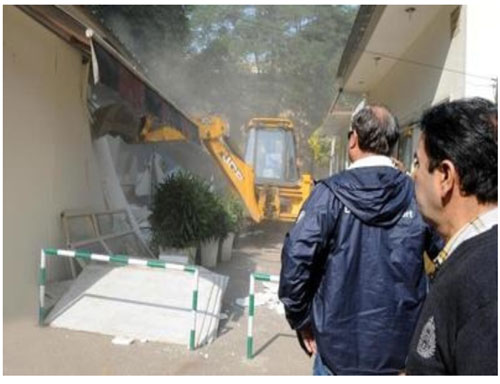Turmoil over common areas in condominium
The Times of India
Lalit Mohan
05 December 2017

Police and DTCP officials entered Heritage City and razed five shops recently amid protest by residents
Demolition of allegedly unauthorised shops put up by the residents'
association in Heritage City, Gurgaon cloaks the more important issue:
who should own common areas in group housing complexes in the state?
This is a matter of contention between the builders and many of the
housing societies in Gurgaon.
The government's response to all such disputes is either to brush them
under the carpet, or side with the developers while taking full
advantage of the weaknesses in the legislation.
The Haryana Apartment Ownership Act (HAOA) was passed to give the
residents of housing complexes in the state the right and the
wherewithal to administer the colonies through their elected
representatives. The spirit of the Act requires that once the area has
been handed over to the owners' body, all common areas and facilities,
too, should be transferred to them. That the law says as well. But in a
clever twist of legalese it leaves it to the builder to declare in the
declaration he files under the Act what constitutes 'common areas'.
In the broad scheme of the HAOA, only three kinds of properties are
mentioned as components of any gated colony: general common areas,
limited common areas and private residences. Whatever facilities—be it
shops, club, school or any other—which the builders try to hold on to,
or sell or lease to private parties, would be classified as private
commercial properties and there is no provision for them in the law.
This is a point made by the Punjab and Haryana High Court in their
judgment in the Silver Oaks case.
That verdict was overturned by the Supreme Court in 2013. The apex
court had two important observations to make. One, that the licensed
area in which the group housing complex known as Silver Oaks is located
also has plotted areas of DLF I in it, hence the residential society of
this complex alone cannot take control of all common facilities. The
court said: "The colonizer could not have included the community and
commercial facilities (in the declaration) because the same is meant
for the benefit of the entire colony, which takes in plotted area and
the group housing society's area as well." Logically it means that
residents of plotted areas outside too can avail of the common
facilities in the gated complex! In any case this situation is a rarity.
Second, the court said that the statute has given a discretion to the
colonizer to include whatever facilities he desired in the common list
because they were built by him 'at his own cost' so he could do what he
liked with them. If this means that the cost of constructing these
facilities was not added to the selling price of the apartments, not
enough evidence was produced before the court to establish this. And
even if it is correct in accounting terms, it is contrary to the spirit
of the law.
Unfortunately, the building sector is not known for transparency of its
accounts. But the government can still set up a mechanism by which the
correct cost of building these structures can be ascertained and the
apartment owners' associations given the option of buying them off. And
for the future, the law must be amended unequivocally to give societies
of apartment owners full control over all facilities. If that means
that developers will load the cost of constructing them on the buyers
(which they may have done in the past, too, but keep this fact cleverly
hidden), so be it. At least this matter will be removed from the list
of contentious issues that bedevil the realty sector.
top contents
chapter previous next
